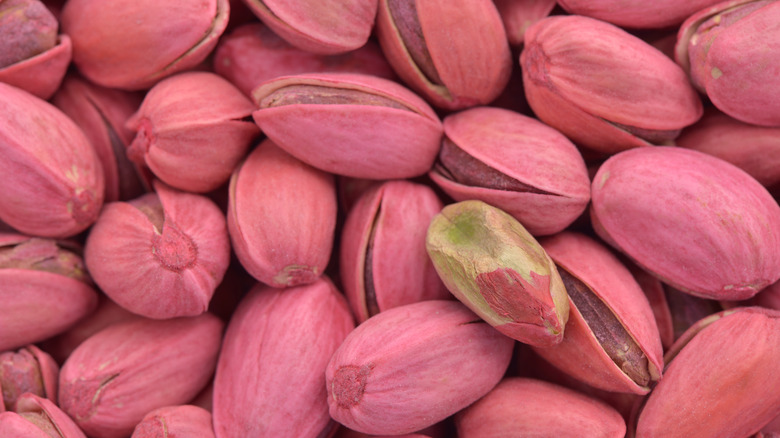Why Pistachios Used To Be Red
Shop for nut products in the 1970s, and options might include the nostalgic Koogle peanut butter spread, the crunchy delights of a peanut and coconut Chick-O-Stick, and a bag of red pistachios. Looking back, the first two options make sense — they're cult-favorite brand items — but brightly colored pistachios? What's that all about?
Intriguingly, no one's quite sure why producers started coloring the pistachio shell (the interior nut would typically remain unchanged). The processing utilized a red dye, which didn't impact the taste but did leave lightly colored smudge marks on your fingers. A mild annoyance while snacking, such an attribute proved extra-frustrating when cooking — no one wants to eat red-tinged green beans with pistachio pesto.
Two general theories explain a reason for the coloration. Some cite that a New York-based importer, Zaloom, started the trend in the early 1900s in an effort to lend pistachios a more eye-catching appearance. Alternatively, some believe the practice started to cover up shell discoloration, since naturally dried pistachios can readily pick up blemishes. Regardless, the once-widespread practice lingered into the 1980s, then disappeared off American shelves entirely.
The California nut industry eliminated the red pistachio trend
While the emergence of red pistachios isn't well documented, their disappearance can be explained — a shift in sourcing. Amidst the colored nut era, pistachios predominantly hailed from the Middle East, with Iran a leading producer. Then the 1979 Iranian Revolution occurred, straining American-Iranian relations (as seen in the movie "Argo"), and leading to a two-year import embargo.
The Californian commercial pistachio industry had only started in 1976, but farmers wondrously quickly expanded production. Incentivized by lower tax rates, agricultural areas like the San Joaquin Valley went all-in on the pistachio. Even when the Iranian nut reappeared several years after the ban, agricultural cooperation helped enact a steep import tariff in 1986, further favoring the American pistachio.
Newfound industrial harvesting techniques curtailed shell blemishes. So unlike the importers handling Middle Eastern pistachios, Californian producers didn't need to color the nuts. The homegrown industry only kept growing; the U.S. is now the world's leading pistachio producer, per the USDA. Subsequently, the dyeing practice became lost in time. So whether you're buying the nut to craft a Sicilian pistachio spread or snack on it standalone, remember this once-prevalent quirk.


